The Ultimate Guide to Polka Dot Plant Care
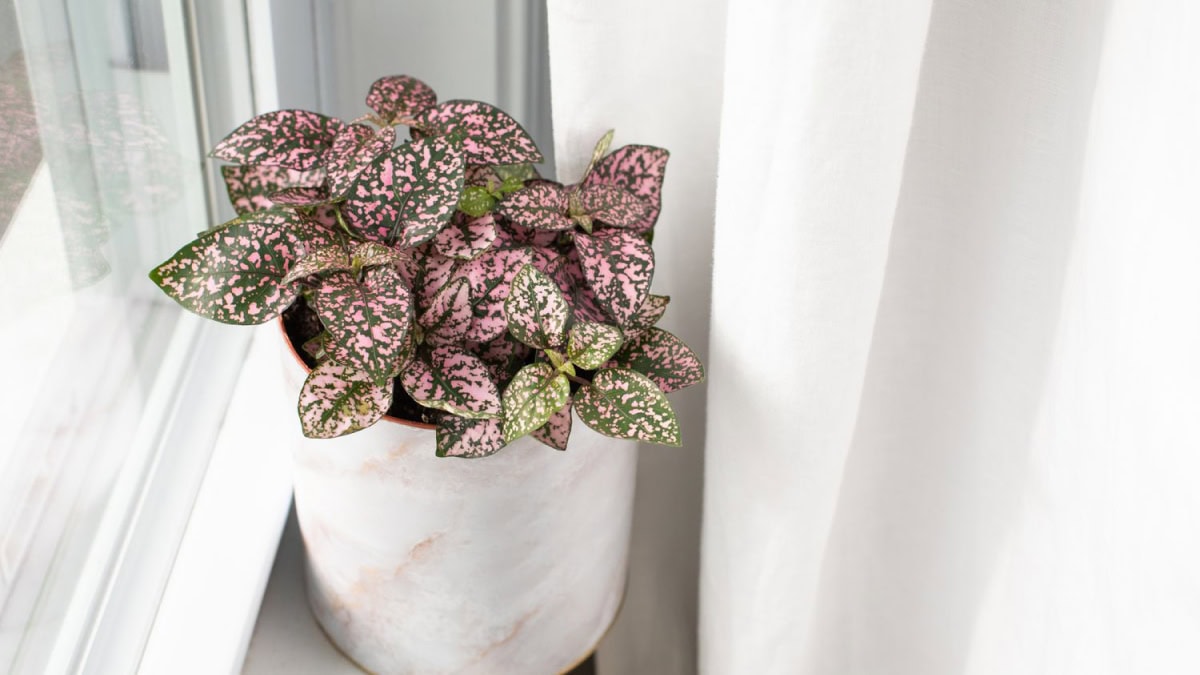
The Polka Dot Plant, scientifically known as Hypoestes phyllostachya, is a delightful houseplant beloved for its vibrant foliage. Originating from Madagascar, this plant is famous for the unique speckled patterns on its leaves, resembling tiny polka dots. Available in various colors, including pink, white, and red, the Polka Dot Plant adds a splash of color and texture to any indoor space. Whether you’re a seasoned plant enthusiast or a beginner, the Polka Dot Plant’s easy-care nature makes it a popular choice for brightening up your home.
Polka Dot Plant’s Aesthetic Appeal
One of the most captivating features of the Polka Dot Plant is its striking foliage. The leaves are dotted with contrasting spots that give the plant its name, with pink being the most sought-after color. These vibrant spots can vary in intensity, creating a mesmerizing visual effect that instantly catches the eye. Whether placed on a windowsill or as part of a larger indoor garden, the Polka Dot Plant’s playful patterns and bright colors make it a perfect choice for those looking to add a touch of whimsy to their decor.
Optimal Growing Conditions
To keep your Polka Dot Plant thriving, it’s essential to recreate the warm, humid environment of its native Madagascar. Place your plant in a spot that receives bright, indirect light—too much direct sunlight can cause the vibrant colors to fade, while too little light may lead to leggy growth. Water your plant regularly, ensuring the soil remains consistently moist but not waterlogged. A well-draining potting mix is ideal to prevent root rot. Additionally, maintaining high humidity levels and a temperature range between 65°F and 80°F will help your Polka Dot Plant stay healthy and colorful.
Comprehensive Care Guide
Caring for a Polka Dot Plant involves a few key practices to keep it looking its best. Regular pruning is important to maintain its bushy shape and prevent it from becoming leggy. Use clean, sharp scissors to trim back any overgrown stems, encouraging new growth. Feeding your Polka Dot Plant with a balanced liquid fertilizer every two weeks during the growing season will also support healthy foliage. Keep an eye out for common pests like aphids or spider mites, and treat infestations promptly with insecticidal soap. By following these simple care steps, your Polka Dot Plant will continue to flourish, displaying its signature spots with pride.
Soil Care
For Polka Dot Plants (Hypoestes phyllostachya), selecting the right soil type is crucial for maintaining their health and promoting vibrant growth. Here’s a guide to the best soil types for these plants:
1. Well-Draining Potting Mix
Polka Dot Plants thrive in soil that drains well, as they are prone to root rot if left in waterlogged conditions. A general-purpose potting mix that contains ingredients like perlite, vermiculite, or coarse sand is ideal. These components help improve soil aeration and drainage, ensuring that excess water doesn’t accumulate around the roots.
2. Peat-Based Mix
A peat-based potting mix is also a good choice for Polka Dot Plants. Peat moss helps retain moisture without making the soil too heavy or compact. It also has a slightly acidic pH, which Polka Dot Plants prefer. To make an effective peat-based mix, combine peat moss with perlite or vermiculite to improve drainage and aeration.
3. Organic Matter-Rich Soil
Polka Dot Plants benefit from a soil mix rich in organic matter, which provides essential nutrients and retains moisture effectively. Adding compost or well-rotted manure to the potting mix can enhance its nutrient content and improve the overall structure of the soil, making it more conducive to healthy root growth.
4. Commercial Potting Mix for Indoor Plants
You can also use a high-quality commercial potting mix designed specifically for indoor plants. These mixes are typically well-balanced, containing a mix of peat, perlite, and other organic materials that cater to the needs of houseplants like Polka Dot Plants.
5. Custom Mix for Polka Dot Plants
For those who prefer to create a custom soil mix, consider combining the following ingredients:
- 2 parts peat moss or coco coir (for moisture retention)
- 1 part perlite or coarse sand (for improved drainage)
- 1 part compost or aged manure (for added nutrients)
Tips for Maintaining Healthy Soil:
- Regularly Check Soil Moisture: Ensure the soil remains consistently moist but not soggy. Water when the top inch of the soil feels dry.
- Repotting: Repot your Polka Dot Plant every 1-2 years with fresh soil to replenish nutrients and provide more space for root growth.
- Soil pH: Polka Dot Plants prefer slightly acidic soil, with a pH range of 5.5 to 6.5. You can test the soil pH and adjust it if necessary using soil amendments like sulfur (to lower pH) or lime (to raise pH).
By using a well-draining, nutrient-rich soil mix, you can help ensure that your Polka Dot Plant thrives, displaying its vibrant colors and healthy growth.
Water Requirements
Polka Dot Plants (Hypoestes phyllostachya) have specific water requirements that, when met, can help them thrive and maintain their vibrant foliage. Here’s a detailed guide on how to water your Polka Dot Plant effectively:
1. Consistent Moisture
Polka Dot Plants prefer consistently moist soil, but it’s important to avoid waterlogging, which can lead to root rot. The soil should remain damp, but not soggy. Here’s how to achieve the right balance:
- Check Soil Moisture: Before watering, check the moisture level by inserting your finger about an inch into the soil. If it feels dry at that depth, it’s time to water. If it’s still damp, wait a day or two before checking again.
- Watering Frequency: During the growing season (spring and summer), Polka Dot Plants may need watering about once or twice a week, depending on the humidity and temperature of your environment. In the dormant season (fall and winter), reduce watering frequency to once every 10-14 days, as the plant’s growth slows down.
2. Watering Method
The method you use to water your Polka Dot Plant can impact its health. Here are some best practices:
- Water at the Base: Water directly at the base of the plant to ensure that the moisture reaches the roots. Avoid getting water on the leaves, as this can lead to fungal issues.
- Use Room Temperature Water: Water your plant with room temperature water to avoid shocking the roots. Cold water can stress the plant, especially if it’s kept in a warmer environment.
- Drain Excess Water: Ensure that your pot has drainage holes to allow excess water to escape. After watering, let the plant drain completely, and never let it sit in standing water.
3. Signs of Overwatering and Underwatering
Understanding the signs of both overwatering and underwatering is key to maintaining the health of your Polka Dot Plant:
- Overwatering Signs: Yellowing leaves, wilting despite moist soil, and a soggy potting mix are signs of overwatering. If you notice these symptoms, allow the soil to dry out slightly and reduce your watering frequency.
- Underwatering Signs: If the leaves begin to wilt or the plant looks droopy, it may be a sign of underwatering. Additionally, crispy leaf edges can indicate that the plant isn’t getting enough water. In this case, increase your watering frequency and ensure that the soil is adequately moist.
4. Humidity Considerations
Polka Dot Plants also thrive in environments with higher humidity. To maintain adequate moisture levels:
- Mist the Plant: Lightly mist your Polka Dot Plant’s leaves daily, especially if the air in your home is dry. This helps replicate the humid conditions of its native environment.
- Use a Humidity Tray: Place the pot on a tray filled with water and pebbles. As the water evaporates, it increases the humidity around the plant.
- Group with Other Plants: Placing your Polka Dot Plant near other houseplants can naturally increase humidity through the process of transpiration.
5. Seasonal Adjustments
Adjust your watering routine based on the seasons:
- Spring and Summer: During the warmer months, when the plant is actively growing, it will require more frequent watering. Monitor the soil closely and adjust as needed.
- Fall and Winter: In cooler months, reduce watering frequency as the plant’s growth slows down. Overwatering during this period can lead to root rot and other issues.
6. Water Quality
The quality of water used can also affect the health of your Polka Dot Plant:
- Avoid Hard Water: If your tap water is high in minerals (hard water), consider using filtered or distilled water to prevent mineral buildup in the soil.
- Rainwater: If possible, collect rainwater for your plants, as it’s free of chemicals and usually has a balanced pH that plants love.
By following these watering guidelines, you can ensure that your Polka Dot Plant remains healthy, vibrant, and full of life. Proper watering, combined with the right light, soil, and humidity, will help your plant thrive and display its beautiful, colorful foliage
Polka Dot Plant Varities & Types
Polka Dot Plants (Hypoestes phyllostachya) are beloved for their colorful and speckled foliage, and they come in various varieties that offer unique visual appeal. Here’s a look at some of the most popular Polka Dot Plant varieties:
1. Pink Polka Dot Plant (Hypoestes phyllostachya ‘Pink’)
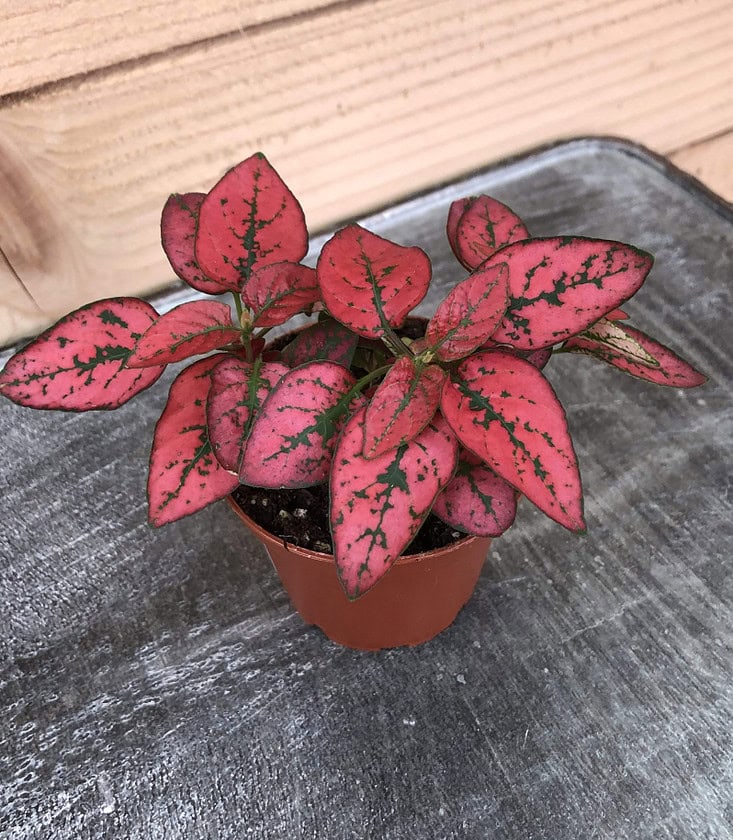
- Appearance: This is the most common and popular variety, characterized by its vibrant pink leaves with dark green spots. The pink spots can vary in intensity, sometimes almost covering the entire leaf.
- Care: Like all Polka Dot Plants, it thrives in bright, indirect light and prefers consistently moist soil. Regular pruning helps maintain its bushy appearance.
2. White Polka Dot Plant (Hypoestes phyllostachya ‘White’)
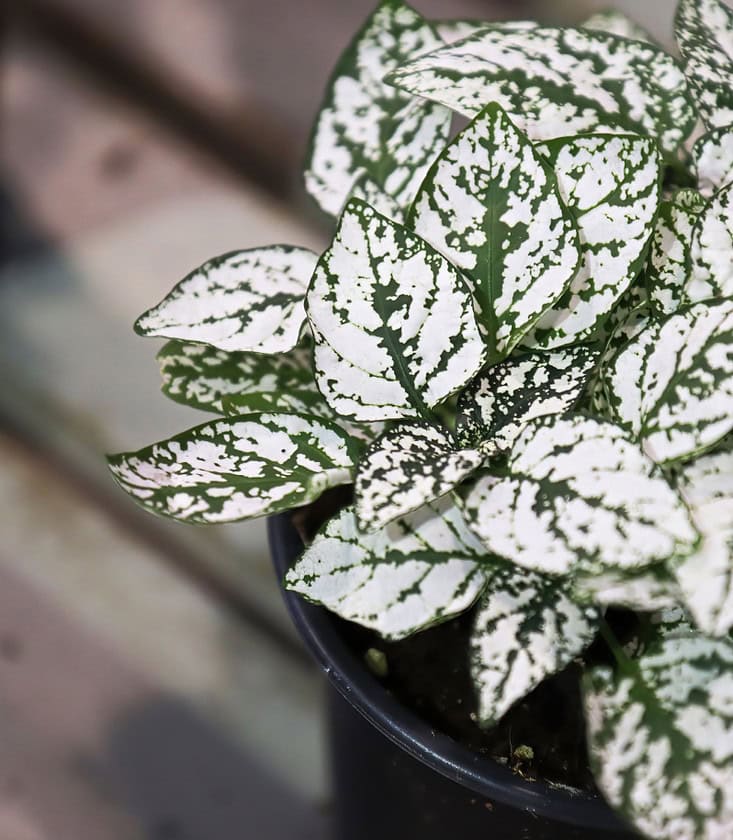
- Appearance: The White Polka Dot Plant features white spots on green leaves, offering a more subtle but equally striking look. The contrast between the white and green gives it a delicate, almost lace-like appearance.
- Care: Similar care requirements to the pink variety, though it may tolerate slightly lower light conditions, making it a good choice for rooms with less natural light.
3. Red Polka Dot Plant (Hypoestes phyllostachya ‘Red’)
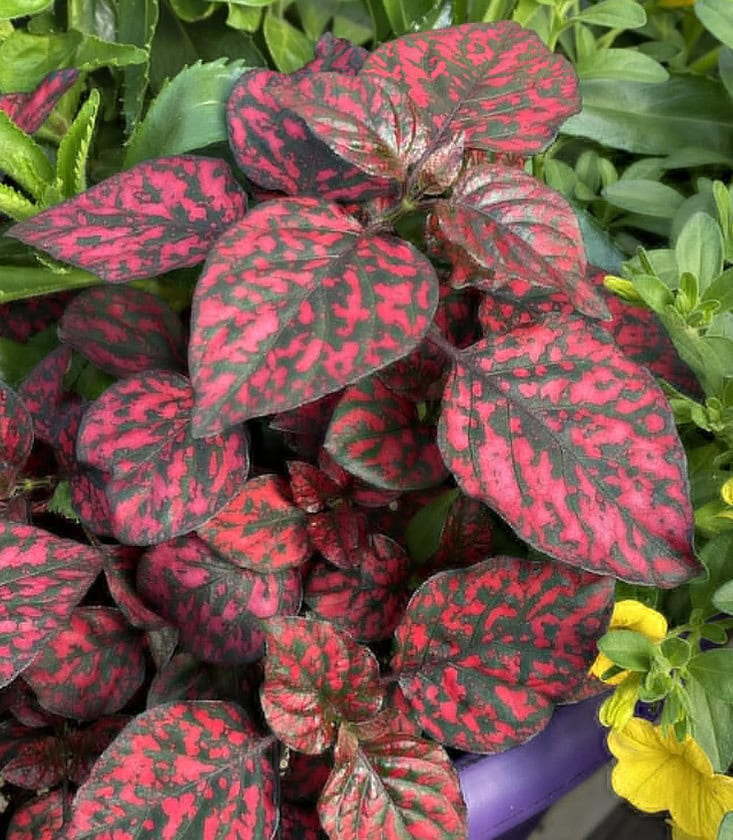
- Appearance: This variety is known for its deep red spots on green leaves, creating a bold and dramatic effect. The red can range from bright scarlet to deep burgundy, depending on the light conditions.
- Care: Requires bright, indirect light to maintain the intensity of the red color. Regular feeding during the growing season helps keep the foliage vibrant.
4. Splash Series
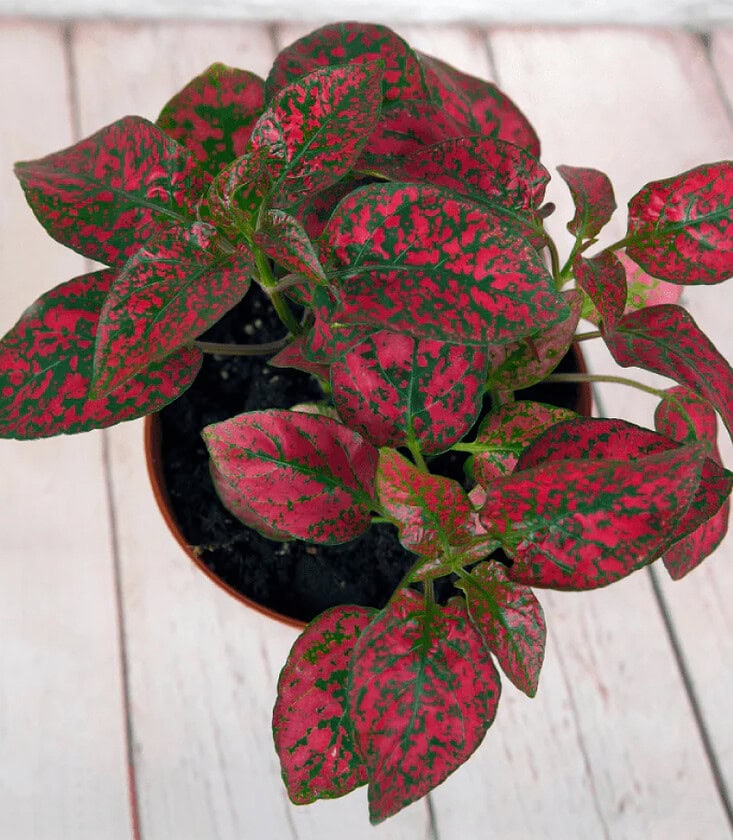
- Appearance: The Splash Series includes a range of Polka Dot Plants with vibrant, contrasting colors. These plants often have a more mottled appearance, with the spots covering a larger portion of the leaf surface.
- Varieties:
- ‘Splash Pink’: Features pink and green foliage with more irregular splashes of color.
- ‘Splash White’: Displays white and green leaves with more extensive white coverage.
- ‘Splash Red’: Offers a striking red and green combination with a splashy, variegated look.
- Care: These varieties are typically easy to care for and thrive in similar conditions to the standard Polka Dot Plants. They are particularly popular for adding variety and texture to indoor plant collections.
5. Confetti Series

- Appearance: The Confetti Series is similar to the Splash Series but typically features smaller, more delicate leaves with a finer pattern of spots. The colors are soft and muted, creating a confetti-like effect on the foliage.
- Varieties:
- ‘Confetti Pink’: Soft pink spots on green leaves, resembling a gentle sprinkle of confetti.
- ‘Confetti White’: Subtle white speckles on green, giving a light and airy appearance.
- ‘Confetti Red’: Delicate red spots on green, providing a more understated color contrast.
- Care: These plants are well-suited for small spaces and can be grouped together for a charming display. They require the same basic care as other Polka Dot Plants, with attention to moisture and light.
6. Camina Series

- Appearance: The Camina Series features unique color patterns, often with darker, more intense shades and smaller, more defined spots. This series is less common but highly prized for its distinct appearance.
- Varieties:
- ‘Camina Rose’: Darker pink spots with a hint of rose on deep green leaves.
- ‘Camina White’: Bright white spots on darker green foliage, creating a high-contrast look.
- Care: These plants may require slightly more care in terms of maintaining consistent light levels to ensure their colors stay rich and vibrant.
7. Purple Polka Dot Plant (Hypoestes phyllostachya ‘Purple’)
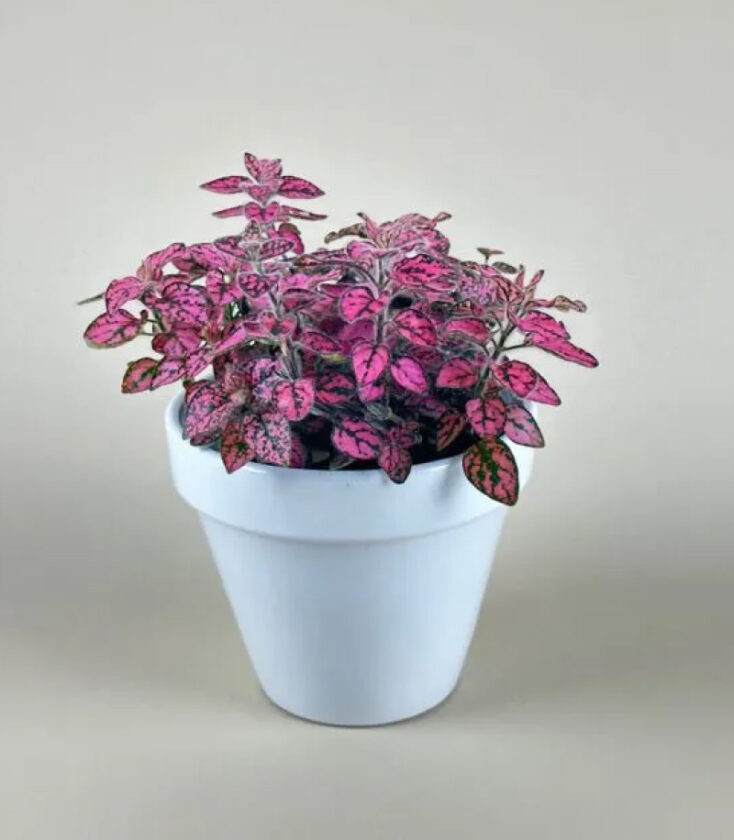
- Appearance: A rarer variety, this plant features purple spots on green leaves, adding a unique and exotic touch to any indoor garden.
- Care: This variety can be slightly more demanding in terms of light, requiring bright, indirect light to maintain the intensity of the purple color. It’s a great choice for those looking to add a touch of the unusual to their plant collection.
Propagation Techniques for Polka Dot Plant
Propagating Polka Dot Plants is a rewarding process that allows you to create new plants from cuttings. One of the simplest methods is water propagation. Start by cutting a healthy stem just below a node, removing any leaves near the base. Place the cutting in a glass of water, ensuring the node is submerged. Within a few weeks, roots should begin to form. Once the roots are a few inches long, you can transfer the cutting to a pot filled with well-draining soil. Keep the soil moist and provide bright, indirect light to help your new plant establish itself.
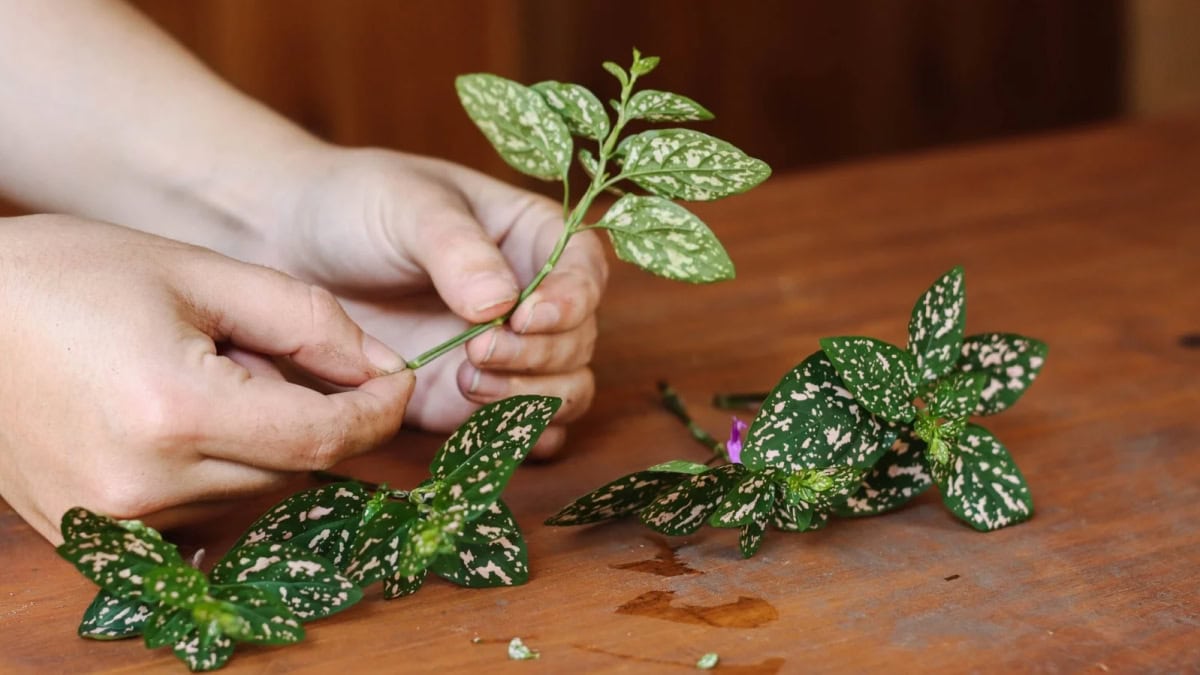
1. Water Propagation
Water propagation is one of the easiest methods for beginners. Here’s how you can ensure success:
- Select the Right Cutting: Choose a healthy stem with at least one or two nodes (the part of the stem where leaves emerge). Cut just below a node, and remove the leaves from the lower half of the cutting.
- Use Clean Water: Place the cutting in a clean glass of water, ensuring that the node is submerged. Change the water every few days to prevent stagnation and bacteria buildup.
- Provide Optimal Conditions: Place the glass in a spot with bright, indirect light. Avoid direct sunlight, which can overheat the water and stress the cutting.
- Transplanting: Once the roots are about 2-3 inches long, transfer the cutting to a small pot with well-draining soil. Keep the soil consistently moist as the plant acclimates to its new environment.
2. Soil Propagation
Soil propagation is another effective method, especially for those who want to bypass the water stage:
- Prepare the Cutting: Just like in water propagation, start with a healthy stem cutting. Remove the lower leaves to leave a bare stem that can be buried in soil.
- Use Rooting Hormone: Dip the cut end of the stem in a rooting hormone to encourage faster root development. While this step is optional, it can significantly increase the chances of successful propagation.
- Planting: Insert the cutting into a small pot filled with a well-draining potting mix. Firmly press the soil around the stem to provide support.
- Maintain Humidity: Cover the pot with a plastic bag or a clear dome to create a humid environment, which helps in root formation. Ensure that the plastic doesn’t touch the cutting by using small stakes to prop it up.
- Care: Place the pot in a warm spot with indirect light. Keep the soil moist but not soggy. Roots should start to develop within a few weeks, and new leaf growth will signal a successful propagation.
3. Division
For mature Polka Dot Plants that have grown too large or developed multiple stems, division can be an effective method:
- Remove the Plant: Carefully remove the entire plant from its pot, being gentle with the roots.
- Separate the Roots: Gently tease apart the roots to separate the plant into smaller sections. Ensure each section has a good amount of roots and a few stems.
- Replant: Plant each section in its own pot filled with fresh, well-draining soil. Water thoroughly after planting to help the new divisions establish.
- Post-Division Care: Keep the newly potted plants in a warm, humid environment and provide indirect light. Continue regular watering as the plants adapt to their new pots.
4. Propagation in Perlite
Perlite, a lightweight, porous medium, can also be used for propagation:
- Prepare the Cutting: Follow the same steps as for soil propagation, using a healthy stem cutting.
- Plant in Perlite: Fill a small pot with damp perlite and insert the cutting. Perlite’s excellent drainage properties make it ideal for root development.
- Maintain Moisture: Keep the perlite moist but not waterlogged. You can mist it regularly or water from below by placing the pot in a tray of water and allowing it to absorb moisture.
- Transitioning: Once the cutting has developed roots, it can be carefully transplanted into a potting mix.
5. Leaf Cuttings (Experimental)
While not commonly practiced with Polka Dot Plants, leaf cuttings can sometimes yield new plants:
- Select a Leaf: Choose a healthy, mature leaf and cut it cleanly from the plant.
- Rooting Hormone: Dip the cut edge in rooting hormone to encourage root formation.
- Planting: Place the leaf flat on the surface of damp potting mix, pressing it down gently. Some gardeners also cover the cut end slightly with soil.
- Care: Keep the soil moist and provide bright, indirect light. Over time, small plantlets may form at the base of the leaf.
Tips for Successful Propagation:
- Timing: The best time to propagate Polka Dot Plants is during the growing season (spring and summer) when the plant is actively growing.
- Monitoring: Regularly check on your cuttings or divisions for signs of root growth or stress. Adjust care as needed.
- Patience: Propagation can take a few weeks to show visible results. Be patient and maintain consistent care for the best outcomes.
Polka Dot Plant Varieties and Care Differences
While the pink-spotted variety is the most popular, Polka Dot Plants come in several other color variations, including white, red, and even green. Each variety brings its own charm, though their care requirements are largely similar. The main difference lies in light exposure—darker varieties may tolerate lower light conditions better than their lighter counterparts. Understanding these subtle differences can help you select the perfect Polka Dot Plant for your home and ensure it thrives in its environment.
Common Mistakes and How to Avoid Them
One of the most common mistakes in Polka Dot Plant care is overwatering. While these plants enjoy moist soil, they are susceptible to root rot if left in waterlogged conditions. Always check the soil before watering—if the top inch feels dry, it’s time to water. Another frequent issue is insufficient light, which can lead to dull colors and leggy growth. Ensure your plant receives plenty of indirect light, and consider rotating it regularly to expose all sides to the light source. By being mindful of these potential pitfalls, you can avoid common care mistakes and keep your Polka Dot Plant thriving.
Frequently Asked Questions (FAQs)
How often should I water my Polka Dot Plant?
Water your Polka Dot Plant when the top inch of soil feels dry. Avoid overwatering to prevent root rot.
Can I grow a Polka Dot Plant outdoors?
Yes, Polka Dot Plants can be grown outdoors in warm, humid climates with indirect light.
Why are the leaves of my Polka Dot Plant turning yellow?
Yellow leaves may indicate overwatering or insufficient light. Adjust your care routine accordingly.
Are Polka dot plants safe for pets?
Polka Dot Plants (Hypoestes phyllostachya) are generally considered non-toxic to pets such as cats, dogs, and horses. According to the ASPCA (American Society for the Prevention of Cruelty to Animals), these plants are not listed as harmful or poisonous to animals.
Decorating with Polka Dot Plants
Polka Dot Plants are incredibly versatile when it comes to home decor. Their bright, speckled leaves make them an excellent choice for adding a pop of color to any room. Consider placing a few Polka Dot Plants in decorative pots on your windowsill or arranging them with other houseplants to create a lush indoor garden. Their compact size also makes them perfect for terrariums or as an accent plant in larger indoor displays. Whether you prefer a minimalist look or a more vibrant, eclectic style, Polka Dot Plants can easily complement your decor, adding both beauty and character to your space.
The Joy of Growing Polka Dot Plants
Growing Polka Dot Plants is a rewarding experience that brings a touch of nature’s whimsy into your home. With their easy-care nature and striking appearance, these plants are perfect for both novice and experienced gardeners alike. Whether you’re looking to add a splash of color to your living space or experiment with plant propagation, Polka Dot Plants offer endless possibilities. Embrace the joy of nurturing these vibrant plants and watch as they transform your home with their playful patterns and lively colors.